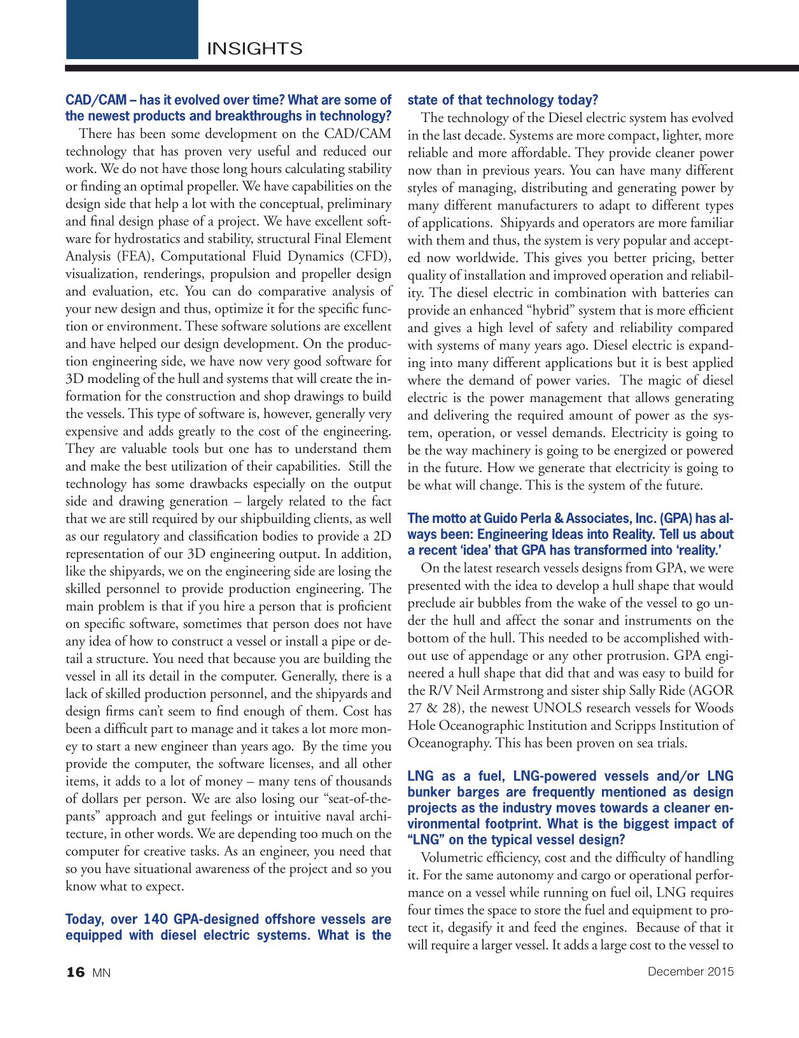
Page 16: of Marine News Magazine (December 2015)
Innovative Products & Boats of 2015
Read this page in Pdf, Flash or Html5 edition of December 2015 Marine News Magazine
INSIGHTS
CAD/CAM – has it evolved over time? What are some of state of that technology today?
the newest products and breakthroughs in technology?
The technology of the Diesel electric system has evolved
There has been some development on the CAD/CAM in the last decade. Systems are more compact, lighter, more technology that has proven very useful and reduced our reliable and more affordable. They provide cleaner power work. We do not have those long hours calculating stability now than in previous years. You can have many different or ? nding an optimal propeller. We have capabilities on the styles of managing, distributing and generating power by design side that help a lot with the conceptual, preliminary many different manufacturers to adapt to different types and ? nal design phase of a project. We have excellent soft- of applications. Shipyards and operators are more familiar ware for hydrostatics and stability, structural Final Element with them and thus, the system is very popular and accept-
Analysis (FEA), Computational Fluid Dynamics (CFD), ed now worldwide. This gives you better pricing, better visualization, renderings, propulsion and propeller design quality of installation and improved operation and reliabil- and evaluation, etc. You can do comparative analysis of ity. The diesel electric in combination with batteries can your new design and thus, optimize it for the speci? c func- provide an enhanced “hybrid” system that is more ef? cient tion or environment. These software solutions are excellent and gives a high level of safety and reliability compared and have helped our design development. On the produc- with systems of many years ago. Diesel electric is expand- tion engineering side, we have now very good software for ing into many different applications but it is best applied 3D modeling of the hull and systems that will create the in- where the demand of power varies. The magic of diesel formation for the construction and shop drawings to build electric is the power management that allows generating the vessels. This type of software is, however, generally very and delivering the required amount of power as the sys- expensive and adds greatly to the cost of the engineering. tem, operation, or vessel demands. Electricity is going to
They are valuable tools but one has to understand them be the way machinery is going to be energized or powered and make the best utilization of their capabilities. Still the in the future. How we generate that electricity is going to technology has some drawbacks especially on the output be what will change. This is the system of the future. side and drawing generation – largely related to the fact
The motto at Guido Perla & Associates, Inc. (GPA) has al- that we are still required by our shipbuilding clients, as well ways been: Engineering Ideas into Reality. Tell us about as our regulatory and classi? cation bodies to provide a 2D a recent ‘idea’ that GPA has transformed into ‘reality.’ representation of our 3D engineering output. In addition,
On the latest research vessels designs from GPA, we were like the shipyards, we on the engineering side are losing the skilled personnel to provide production engineering. The presented with the idea to develop a hull shape that would main problem is that if you hire a person that is pro? cient preclude air bubbles from the wake of the vessel to go un- on speci? c software, sometimes that person does not have der the hull and affect the sonar and instruments on the bottom of the hull. This needed to be accomplished with- any idea of how to construct a vessel or install a pipe or de- tail a structure. You need that because you are building the out use of appendage or any other protrusion. GPA engi- vessel in all its detail in the computer. Generally, there is a neered a hull shape that did that and was easy to build for lack of skilled production personnel, and the shipyards and the R/V Neil Armstrong and sister ship Sally Ride (AGOR design ? rms can’t seem to ? nd enough of them. Cost has 27 & 28), the newest UNOLS research vessels for Woods
Hole Oceanographic Institution and Scripps Institution of been a dif? cult part to manage and it takes a lot more mon- ey to start a new engineer than years ago. By the time you Oceanography. This has been proven on sea trials.
provide the computer, the software licenses, and all other
LNG as a fuel, LNG-powered vessels and/or LNG items, it adds to a lot of money – many tens of thousands bunker barges are frequently mentioned as design of dollars per person. We are also losing our “seat-of-the- projects as the industry moves towards a cleaner en- pants” approach and gut feelings or intuitive naval archi- vironmental footprint. What is the biggest impact of tecture, in other words. We are depending too much on the “LNG” on the typical vessel design?
computer for creative tasks. As an engineer, you need that
Volumetric ef? ciency, cost and the dif? culty of handling so you have situational awareness of the project and so you it. For the same autonomy and cargo or operational perfor- know what to expect. mance on a vessel while running on fuel oil, LNG requires four times the space to store the fuel and equipment to pro-
Today, over 140 GPA-designed offshore vessels are tect it, degasify it and feed the engines. Because of that it equipped with diesel electric systems. What is the will require a larger vessel. It adds a large cost to the vessel to
December 2015
MN 16
MN Dec15 Layout 1-17.indd 16 MN Dec15 Layout 1-17.indd 16 11/24/2015 10:26:27 AM11/24/2015 10:26:27 AM

 15
15

 17
17
